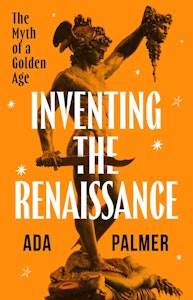This article is taken from the April 2025 issue of The Critic. To get the full magazine why not subscribe? Right now we’re offering five issues for just £10.
Ada Palmer has written a big book. It is unique in character, bewildering in structure, packed with learning and replete with anecdote. At times it is charming, at times annoying, but the end result is an important achievement for our fallen age.
To reassess the Renaissance is a daunting prospect. Leaving aside the sheer temporal, spatial, cultural, political and intellectual breadth of the movement claiming that name — a good quarter-millennium of headspinning innovation, reinvention and reformation — the Renaissance phenomenon can only be comprehended by playing both the Colossus and the Janus.
Straddling the period in a painful stretch, the historian must at once look back to Greco-Roman antiquity and survey the long stretch in between — now perforce the “Middle Ages” — while also looking forward to the incalculable effects the Renaissance has had on the later world, Old and New. And you’re only fit to strike this pose if you’ve passed through the obstacle course, several hundred yards long, of essential scholarly reading.
For all the iconoclastic myth-busting and unrelenting veil-pulling, Palmer ends on amusingly familiar ground
In Inventing the Renaissance, Palmer, an admirably wide-ranging historian at the University of Chicago, sets herself three further challenges. First, to cut through the rhetorical bluster of many Renaissance figures about the Golden Age they were so energetically willing into being.
Second, to disaggregate how subsequent centuries have tried to remake the Renaissance in their own image, thus distorting and oversimplifying the period’s kaleidoscopic complexity. Third, and most difficult of all, to present the richness of the Renaissance to a younger readership who not only know little of this period but also have little experience of — and maybe patience for — reading long-form non-fiction history.
The last of these aims has some predictable consequences. The book operates in short bursts of energy — the alarming figure of 67 chapters is leavened by their averaging under ten pages — with titles designed to draw the restless reader in: “Super sexy secular humanism”, “It’s getting weird in Florence”, “We can’t just Abelard harder anymore”. Yes, this framing soon grates, but remember: Palmer could very easily have written a much more academic — and thus much less read — work. Only sales will tell whether the gambit, and the gamble, pay off. I hope it does.
Palmer’s own profile, it should be said, is unusual, since her academic work jostles with a parallel life writing science fiction novels. It’s fair to say that the breezier tone of that genre has been turbo-boosted here: every page is a model of mateyness, filled with the millennial patter of social-media-ready irony. Most of us would run a mile or more from anyone feeling the need to use “very, very, very, very, very, very, very”, “increeeeeeeeedibly booooooring”, “dudes”, “WTF”, along with the glib argot of TikTok #hottakes. But I’m pleased I stuck around, as this all proved to be the veneer to a very well-informed, and disarmingly readable, tome.
The book is flanked by various introductory, methodological and even autobiographical materials to orientate the novice. For such an uninitiated reader, the apparently tangential digressions on the Holy Roman Empire, the Guelphs and Ghibellines and Hellenistic philosophy, in fact provide essential guidance for the body of the book.
While Machiavelli wins out as the dominant character, Palmer focuses on 15 lives — some very well known, some familiar only to specialists. Alongside the obvious cast of Politian, Savaranola, Lucrezia Borgia and Michelangelo, about whom it’s impossible to write boringly, we find Montesecco, Alessandra Strozzi, Alessandra Scala and Camilla Bartolini Rucellai. Most figures get a look-in somewhere over 750 pages, although some inclusions from the seventeenth century are rather less relevant — the polymathic Christina, Queen of Sweden, the controversial deist Charles Blount and the mysterious clairvoyant Julia the Sibyl.
Palmer has a fine eye for detail. To remind us how our distinct historical perspectives can coexist in history, she adduces how, in 1420, Henry V — that epitome of medieval valour — could have sitting at his wedding feast in Troyes that epitome of Renaissance humanism, the great bookhunter Poggio Bracciolini, who then entered the staff of the Bishop of Winchester, Cardinal Beaufort.

And thanks to the happy convenience that the Renaissance florin converts to roughly a thousand dollars today, we can readily reckon that a small Madonna by Fra Angelico cost $5,000, Donatello’s bronze panel of the Madonna $25,000, and a unicorn (= narwhal) horn $5 million. We can compare the average annual salary of a typical humanist lecturer ($50k), with that of Leonardo da Vinci’s from the French court ($700k) or of a celebrated court dwarf ($1 million); and we can marvel that, in 1492, the moveable contents of the Palazzo Medici pile up to $80 million.
Throughout the book, Palmer takes on those heavyweight historians — Jacob Burckhardt, Paul Oskar Kristeller, Eugenio Garin, Hans Baron — who have claimed a particular “X Factor” for the Renaissance. She unpicks their claims in the typical mode that keeps modern historians in post: revealing antecedents that had thought or acted similarly at a yet earlier date, juxtaposing contemporaries who had a very different worldview in the same place and time, and deflating any “great man” or “grand narrative” reading of the Renaissance.
All of this is fair game, but in the end it can amount to crosshatching the same old sketch: the great figures emerge no less great, the Renaissance emerges no less important and all of the X Factors are no less in evidence. While Inventing the Renaissance does reveal how subsequent centuries have imposed their “Myths of a Golden Age”, the chief mythmakers emerge to be those living in that very era: for many Italian humanists, artists and patrons, their intense conviction that they were revivifying the spirit of ancient wisdom, beauty and self-belief did in fact drive their age to unparalleled achievements.
For all the iconoclastic myth-busting and unrelenting veil-pulling, Palmer ends on amusingly familiar ground: she settles for the theory of her Harvard PhD supervisor, James Hankins, who posits “virtue politics” — i.e. an action-based model of nobility — as the best shorthand for understanding how Renaissance humanism worked (and how Machiavelli rebelled). It may be a little underwhelming that, after so long a ride, the book’s conclusion is effectively: “It’s complicated, but your preconceptions are fundamentally correct.”
Two excellent diagrams open the work: a Medici family tree and an eye-wateringly complex flowchart of the shifting allegiances and marital alliances among major Italian families. (Twelve double-headed arrows point to the Milanese magnates Visconti Sforza.) It’s disappointing, then, that the rest of the text is very light on illustration, with just a few black-and-white images appearing sporadically. For such an exuberantly colourful book, the extra cost of inserting some proper plates would have been a well-earned complement.
Though this big book was not written for me, I’m glad to have joined the learned and lucid romp back to where I began. The Renaissance remains recognisable as the golden age of book production, of painting and sculpture, of forging liberal arts education, of merit-based social mobility, of studying and salvaging antiquities and of the world-changing realisation that individual and societal betterment is possible, with history as the liberatory guide to the future.







